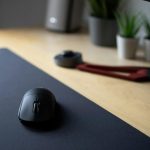When it comes to choosing the right ergonomic mouse, you might feel overwhelmed by the options like trackball, vertical, and standard designs. Each type has unique features tailored to different needs and preferences, impacting your comfort and productivity. Understanding these distinctions can help you make a more informed decision. But how do you know which one truly fits your style and usage? Let's explore the key characteristics of each design.
Table of Contents
Key Takeaways
- Trackball mice allow for stationary hand movement, reducing wrist strain and providing greater precision for tasks like graphic design or gaming.
- Vertical mice promote a natural handshake position, minimizing wrist and forearm strain while enhancing control and comfort during use.
- Standard mice offer a familiar design with ergonomic shapes that help reduce fatigue, making them a versatile and budget-friendly option.
- Consider your grip style—palm, claw, or fingertip—as it significantly impacts comfort and usability across different mouse designs.
- Look for customizable buttons and adjustable DPI settings in any mouse type to enhance productivity and tailor the experience to your needs.
Understanding Ergonomics in Mouse Design
While you mightn't think about it often, the design of your mouse plays a crucial role in your overall comfort and productivity. An ergonomic mouse is crafted to fit the natural shape of your hand, reducing strain during long hours of use.
When you choose a mouse that supports your wrist and encourages a neutral hand position, you minimize the risk of discomfort and repetitive strain injuries. Features like thumb rests and customizable buttons can also enhance your workflow.
Trackball Mice: Features and Benefits
If you're looking for an alternative to traditional mice, trackball mice offer unique features that can enhance your user experience.
These devices allow you to control the cursor with your thumb or fingers while keeping your hand stationary, which can lead to less strain.
Here are some key benefits:
- Reduced Wrist Movement: Since you don't have to move your arm, it minimizes wrist strain.
- Space-Saving Design: Trackball mice require less desk space, making them ideal for small workstations.
- Precision Control: They provide greater precision for tasks like graphic design or gaming.
- Customizable Buttons: Many models come with programmable buttons, enhancing your productivity by allowing quick access to shortcuts.
Consider a trackball for a comfortable and efficient computing experience!
Vertical Mice: Enhancing Hand Position
Vertical mice are designed to promote a more natural hand position, which can significantly reduce strain on your wrist and forearm. By holding a vertical mouse, you're essentially shaking hands with it, keeping your wrist in a neutral position.
This design encourages your arm to stay relaxed, minimizing the risk of repetitive strain injuries.
You'll find that using a vertical mouse feels more comfortable during extended periods of work. The ergonomic grip allows for better control, making it easier to navigate your screen.
Plus, many vertical mice come with customizable buttons, enhancing your productivity. If you're tired of discomfort while using your computer, switching to a vertical mouse might just be the solution you need for a healthier workspace.
Standard Mice: The Traditional Choice
Standard mice remain a popular choice for many users, thanks to their familiar design and ease of use.
They're widely recognized for their functionality and compatibility with various devices. Here are some key features that make them a go-to option:
- Ergonomic Shape: Many standard mice are designed to fit comfortably in your hand, reducing fatigue during long use.
- Versatile Buttons: They often come with customizable buttons, allowing you to tailor your experience.
- Reliable Tracking: Standard mice provide accurate tracking on various surfaces, ensuring smooth navigation.
- Affordability: They're generally more budget-friendly compared to specialized ergonomic options, making them accessible for everyone.
Their straightforward design makes standard mice a reliable choice for everyday computing tasks.
Choosing the Right Mouse for Your Needs
With so many options available, picking the right mouse for your needs can feel overwhelming. Start by considering how you use your computer. If you spend hours gaming or working, a vertical or trackball mouse might reduce strain on your wrist. If you prefer a traditional feel, a standard mouse could work well.
Next, think about your grip style—palm, claw, or fingertip. Each mouse type caters to different grips, enhancing comfort and control.
Also, pay attention to size; it should fit comfortably in your hand. Lastly, consider any special features like customizable buttons or adjustable DPI settings that align with your tasks.
Frequently Asked Questions
Can Ergonomic Mice Help Reduce Wrist Pain?
Yes, ergonomic mice can help reduce wrist pain by promoting a more natural hand position. They're designed to minimize strain, allowing you to work comfortably for longer periods without discomfort or fatigue.
Are There Specific Mice for Left-Handed Users?
Yes, there are specific mice designed for left-handed users. You'll find options that cater to your needs, ensuring comfort and functionality. Choosing the right one can significantly improve your overall computing experience.
Do Ergonomic Mice Require Special Software?
Ergonomic mice don't always require special software, but many come with customizable features that enhance functionality. You can usually adjust settings through software for a more personalized experience, improving comfort and efficiency during use.
How Long Does It Take to Adjust to a New Mouse?
It usually takes you about a week to adjust to a new mouse. Your muscle memory needs time to adapt, so practice regularly, and you'll find yourself getting comfortable with it sooner than you think.
Can Children Use Ergonomic Mice Effectively?
Yes, children can use ergonomic mice effectively. They often adapt quickly to new devices, and the proper fit can enhance comfort and reduce strain, promoting healthier habits during screen time. Just ensure it suits their hand size.




